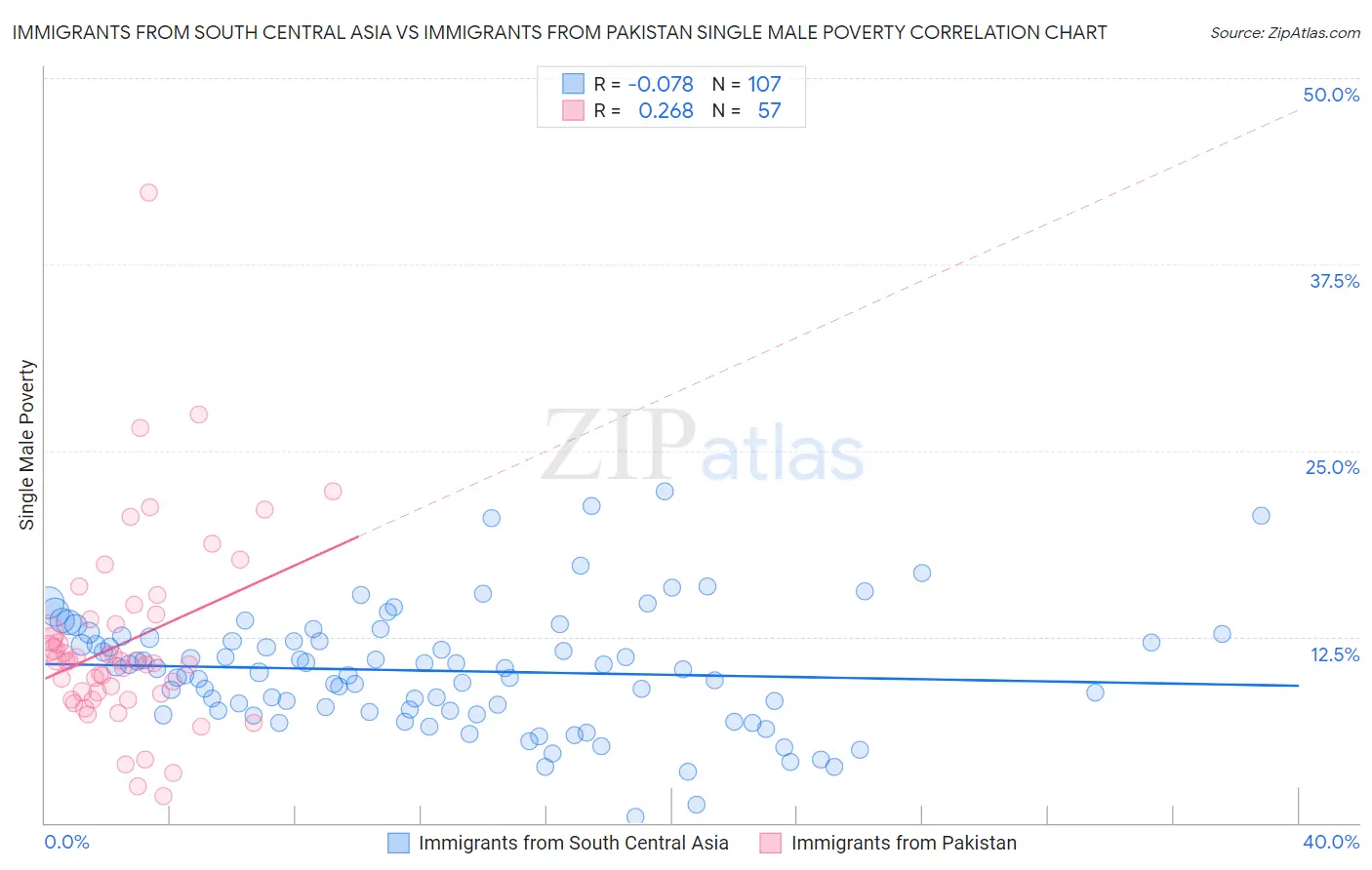Immigrants from South Central Asia vs Immigrants from Pakistan Single Male Poverty
COMPARE
Immigrants from South Central Asia
Immigrants from Pakistan
Single Male Poverty
Single Male Poverty Comparison
Immigrants from South Central Asia
Immigrants from Pakistan
10.9%
SINGLE MALE POVERTY
100.0/ 100
METRIC RATING
13th/ 347
METRIC RANK
11.2%
SINGLE MALE POVERTY
100.0/ 100
METRIC RATING
22nd/ 347
METRIC RANK
Immigrants from South Central Asia vs Immigrants from Pakistan Single Male Poverty Correlation Chart
The statistical analysis conducted on geographies consisting of 409,069,639 people shows a slight negative correlation between the proportion of Immigrants from South Central Asia and poverty level among single males in the United States with a correlation coefficient (R) of -0.078 and weighted average of 10.9%. Similarly, the statistical analysis conducted on geographies consisting of 256,771,473 people shows a weak positive correlation between the proportion of Immigrants from Pakistan and poverty level among single males in the United States with a correlation coefficient (R) of 0.268 and weighted average of 11.2%, a difference of 2.7%.

Single Male Poverty Correlation Summary
| Measurement | Immigrants from South Central Asia | Immigrants from Pakistan |
| Minimum | 0.44% | 1.8% |
| Maximum | 22.2% | 42.3% |
| Range | 21.8% | 40.5% |
| Mean | 10.2% | 12.1% |
| Median | 10.3% | 10.9% |
| Interquartile 25% (IQ1) | 7.5% | 8.5% |
| Interquartile 75% (IQ3) | 12.4% | 13.8% |
| Interquartile Range (IQR) | 4.9% | 5.3% |
| Standard Deviation (Sample) | 4.0% | 6.7% |
| Standard Deviation (Population) | 4.0% | 6.6% |
Demographics Similar to Immigrants from South Central Asia and Immigrants from Pakistan by Single Male Poverty
In terms of single male poverty, the demographic groups most similar to Immigrants from South Central Asia are Immigrants from Afghanistan (10.9%, a difference of 0.12%), Immigrants from Philippines (10.9%, a difference of 0.20%), Immigrants from Fiji (10.9%, a difference of 0.22%), Taiwanese (10.9%, a difference of 0.27%), and Chinese (11.0%, a difference of 0.57%). Similarly, the demographic groups most similar to Immigrants from Pakistan are Asian (11.2%, a difference of 0.090%), Bolivian (11.2%, a difference of 0.21%), Indian (Asian) (11.3%, a difference of 0.41%), Maltese (11.3%, a difference of 0.43%), and Ethiopian (11.2%, a difference of 0.44%).
| Demographics | Rating | Rank | Single Male Poverty |
| Afghans | 100.0 /100 | #7 | Exceptional 10.7% |
| Thais | 100.0 /100 | #8 | Exceptional 10.8% |
| Taiwanese | 100.0 /100 | #9 | Exceptional 10.9% |
| Immigrants | Fiji | 100.0 /100 | #10 | Exceptional 10.9% |
| Immigrants | Philippines | 100.0 /100 | #11 | Exceptional 10.9% |
| Immigrants | Afghanistan | 100.0 /100 | #12 | Exceptional 10.9% |
| Immigrants | South Central Asia | 100.0 /100 | #13 | Exceptional 10.9% |
| Chinese | 100.0 /100 | #14 | Exceptional 11.0% |
| Koreans | 100.0 /100 | #15 | Exceptional 11.0% |
| Bhutanese | 100.0 /100 | #16 | Exceptional 11.1% |
| Tsimshian | 100.0 /100 | #17 | Exceptional 11.1% |
| Immigrants | Bolivia | 100.0 /100 | #18 | Exceptional 11.1% |
| Immigrants | Moldova | 100.0 /100 | #19 | Exceptional 11.2% |
| Ethiopians | 100.0 /100 | #20 | Exceptional 11.2% |
| Asians | 100.0 /100 | #21 | Exceptional 11.2% |
| Immigrants | Pakistan | 100.0 /100 | #22 | Exceptional 11.2% |
| Bolivians | 100.0 /100 | #23 | Exceptional 11.2% |
| Indians (Asian) | 100.0 /100 | #24 | Exceptional 11.3% |
| Maltese | 100.0 /100 | #25 | Exceptional 11.3% |
| Immigrants | Japan | 100.0 /100 | #26 | Exceptional 11.3% |
| Immigrants | China | 100.0 /100 | #27 | Exceptional 11.4% |